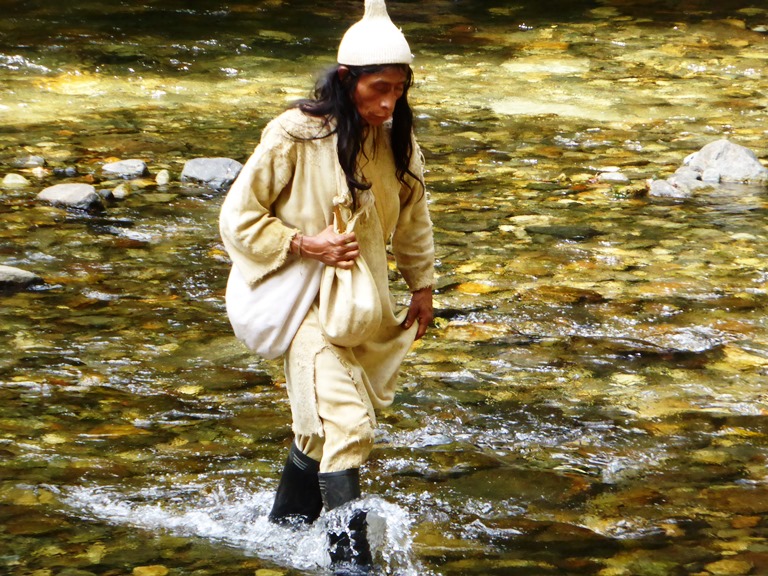Trekking to the Lost City
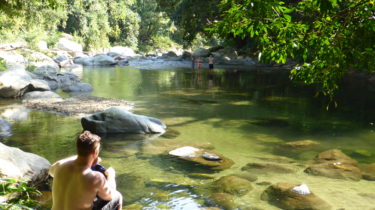
If you do just one thing in Colombia, walk to Teyuna, the Lost City of the Sierra Nevada de Santa Marta. The four-day 47-km hike is hard in places (you can slow it down to 5 or even 6 days for the same cost) but if you are reasonably fit and don´t mind sleeping in a hammock then this is a slice of paradise you will always cherish.
I did this trek in 2016, and as far as I can tell not much has changed (maybe the price!) .

This depends partly on weather, of course. I was blessed with 4 dry days (in January, the dry season) with stunning views over the snow-capped Sierra – the highest coastal mountain range on the planet rising to 5,700 metres – and sun-dappled jungle with a thousand shades of green and sparkling Rio Buritaca where we leaped in to cool off.
Even with no Lost City at the end, it would still make a magnificent trek. But mysterious stone ruin hugging the skirts of the sierra adds a magical goal, similar to Peru’s Machu Picchu.
Lost City Trek v. Inca Trail
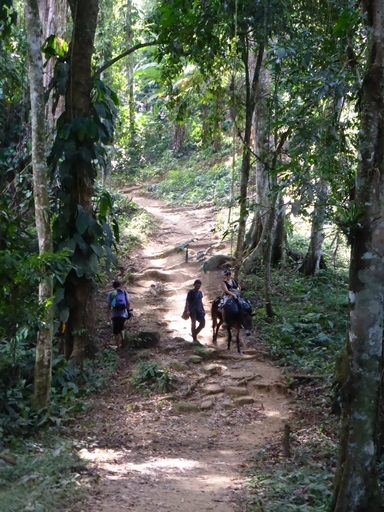
In fact many travellers compare the two treks. The main difference is altitude. The Inca Trail to Machu Picchu is a breathless slog over 4000 metre peaks, while the Lost City is a hot puff over jungle trails. And scale. Machu Picchu is a bigger, more complete and imposing site and sees a million visitors a year. The Lost City is only accessible on foot, making it less touristy and more intimate. Still, there is a constant stream of hikers heading in, around 50 a day (though staggered in smaller groups so you never feel too much of a crowd) so already the pressure is on. See it soon before they build a road!
Another plus for Teyuna, as the lost city is called by the indigenous people of the Buritaca Valley, is it still forms an important part of their culture as a meeting place for the four tribes of the Sierra (Wiwa, Kogi, Arahuaca and Kankuamo) and the site is closed to tourists for some weeks each September as mamos (spiritual leaders) meet. In fact, to the old folk of the Buritaca the stone platforms were never lost at all, rather hidden since conquistador times from the marauding Spanish who pushed the coastal tribes deep into the sierra.
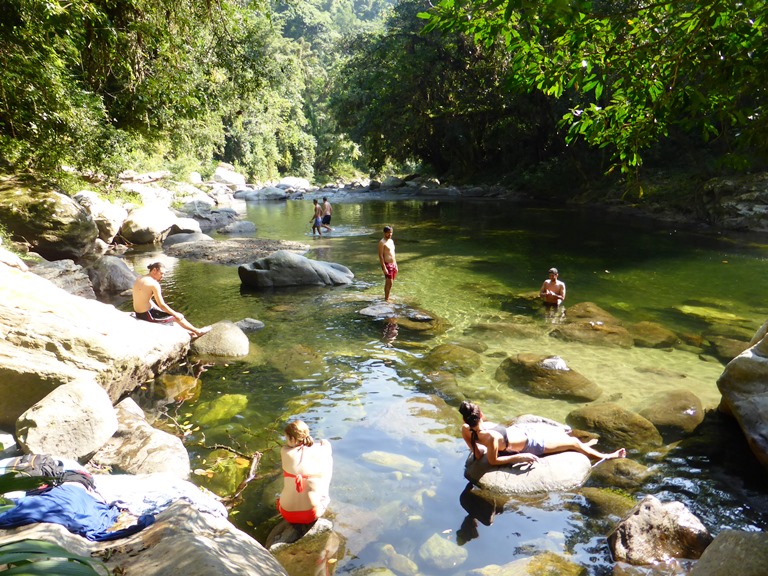
Raiders of the Lost City
Teyuna was ´rediscovered´ by Colombian tomb-raiders (huaqueros) who invaded the Kogi territory in the early 1970s and started selling looted gold artefacts on the illegal antiquities market that flourishes in Latin America. Why didn’t the local tribes stop them?, we ask Manuel, our Wiwa guide showing us the ruins. ´The robbers had guns, they were heavily armed and the Kogi and Wiwa people of the Buritaca Valley have always been peaceful,´ says Manuel. Also 40 years ago the indigenous had minimal contact with Colombian authorities. ´We were very scared,´he explains. One of our tour groups sums it up nicely: ´For them it was like Robocop turning up at the hut door. What could they do?’.
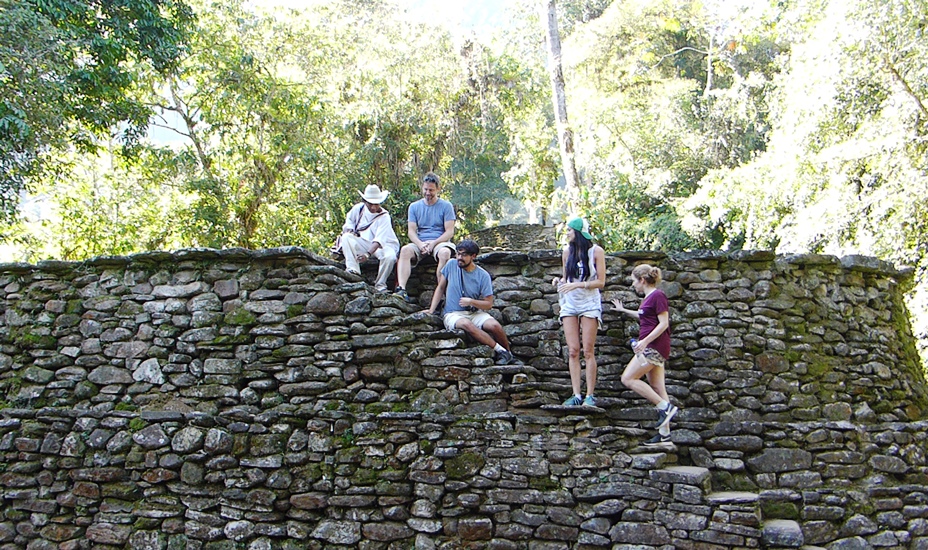
By 1975 the authorities were alerted to the looting and Colombian archaeologists able to broker a deal with the communities whereby official excavation work could take place alongside the presence of state armed forces to protect the site. That this deal was made, and then tourists allowed to visit, is quite remarkable considering the isolation of Teyuna in a wild and untamed corner of Colombia, the Sierra Nevada de Santa Marta. As well as the last retreat of indigenous tribes who avoided the colonial yoke, it is a lawless land steeped in illegal cocaine production and valleys filled with another type of gold, Santa Marta gold, marijuana plants native to the mountains that became a major (illegal) export in the 1970s and kick-started the current drug trade.
The wild jungle terrain has also been home to illegal armed groups such as the FARC and paramilitary gangs. In 2003 left-wing ELN guerrillas kidnapped eight foreign tourists from the Lost City, marched them into the mountains and held them captive for 101 days, supposedly to highlight paramilitary abuses in the area. After their release, the Lost City was off the tourist trail for a few years until a permanent Colombian army base was established at the site itself. Today the Buritaca Valley is ´sano´ (healthy) as Manuel, describes it. But don´t assume other areas of the sierra are the same. The only safe way in to Teyuna is as a paying trekker with an organised tour.
The Wiwa Tour
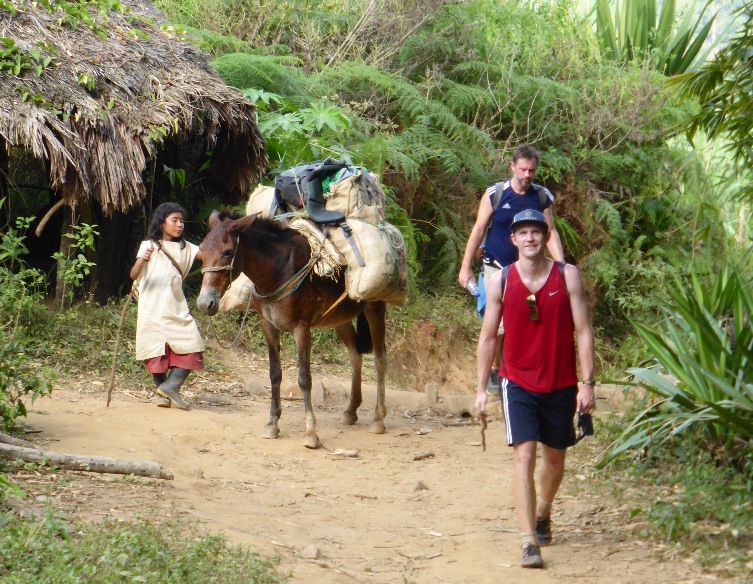
There are six tour companies, mostly based in the coastal city of Santa Marta, and all offer a near-identical trip with a set price (in 2016, 700,000 COP). Trek guides, mule drivers and camp cooks etc are drawn from campesino (farmer) and indigenous communities in the Buritaca Valley, who know the region and respect the indigenous cultures.
Perhaps because it makes sense to visit the Lost City with descendants of the indigenous people who inhabited it, I chose Wiwa Tours which founded and staffed by indigenous Wiwa people. This turns out to be a wise move, our Wiwa guides Manuel and Celso are the real-deal cool-cat Indios in their white tunics, waist-length black hair, always hugging their poporo gourds in which they dip a long stick, then lick the white powder like a kind of mystic sherbert dip-dab. The powder is ground sea-shells from the coast which provide the alkaline catalyst to release the buzzy chemicals from the green coca leaves they chew.

Mambeando, as it is known in Colombia, is part of the wide tradition of the Andes of chewing coca leaves to produce a slight high and spiritual connections. It is quite different from using cocaine (derived but highly concentrated and processed from the same coca leaves) but if overdone can over many years create addiction and health problems, a bit like smoking and whisky. Both Celso and Manuel are constantly digging into their cloth bags of coca leaves for a refill, but don’t seem to be overdoing it yet.
I ask Manuel if the indigenous people see the stream of tourists as a ´new invasion´ into their territory. ´Not really. Actually tourism has helped the Wiwa and Kogi to preserve their cultures,’ he says. As well as their own tour company, money from the trek fees is spread around all the local communities, he explains. But the tribes have to be on their guard, he says. A few years back the ´colonist´ Colombian tour companies battled with the Wiwa over the management of the trek camps on the trail, which the indigenous communities had lost control over. ‘The companies wanted us to pay a lot of money to get them back, but in the end a deal was struck,’ explains Manual.

In a separate case a large tour company – with presidential backing – planned a 7-star tourism resort on ´empty´ land in the indigenous reserve area, but the plans were shelved (for now) after communities blocked it. And as always in Colombia, business interests are shadowed by armed gangs and threats of violence. Survival International has chronicled cases of threats and assassinations of Wiwa, Arhuaco and Kogi leaders in recent years.
Keeping sweet with the locals
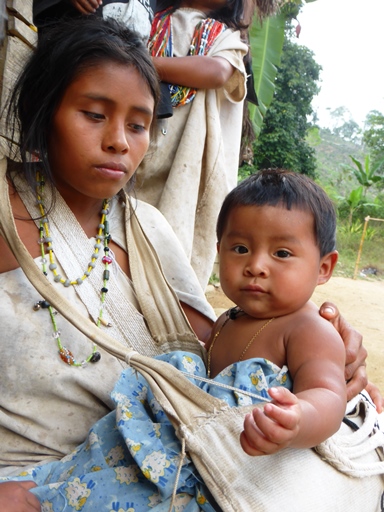
One obvious downside of the tourist trail is the sight of Kogi women constantly swigging Coca Cola and kids begging for sweets. ‘Dulce, dulces’ they chant as more sweaty tourists rock up, happy to hand over some candy in exchange for a photo of the kids. Judging from the rotten teeth, the sweets are doing damage and there are no dentists around. The one health post I saw – half-way up the trail – was shuttered and locked (a common sight in rural Colombia). At one hut where they sold drinks a Kogi mother begged me for ‘medicine´ for her very sick two-year-old child. The girl, covered in raw bug bites and breathing too fast from a chest infection, needed medical treatment. ‘Take her to the health post where there is a nurse, like in Machete,´ I said to the woman, her husband translating into Kogi. Machete is the campesino village at the start of the Lost City trail, a
nd four hour´s drive from Santa Marta. Two days later returning past the hut I asked for the mother and child. Did they go to Machete? ´No, they went back up the mountain´ I was told by some locals.
Mule driving kids
Child labour is also an issue. Our cook assistant is 14 years old, and the mule driver whacking the mules over the dusty trail is just 10. Still, with no schools in the valley you can understand the communities bringing the kids along to help out. But I also saw a Wiwa mother thrash her son (about 6 years old) with a rope because he was playing in the yard. He walked past me, bravely holding back tears, then returned twenty minutes later with a bundle of firewood on his scrawny shoulder.
Most trekkers seemed oblivious to this though, seduced by the Garden-of-Eden lushness of the landscape and novelty of the natives. No one really minds if the locals beat their kids as long as they still look good for the camera. Thankfully changes are coming to valley though, with a rural school due to open this year.
But don´t be put off by my moralising. The fact is the trek works at many different levels, from just grooving on the scenery, to a fascinating glimpse of the complex issues surrounding indigenous people today and perhaps the quite astounding realisation that for the tribes seeking refuge in the Sierra that after 500 years the colonial conquest has never really ended (and this is a reality repeated for many indigenous communities all over Latin America).
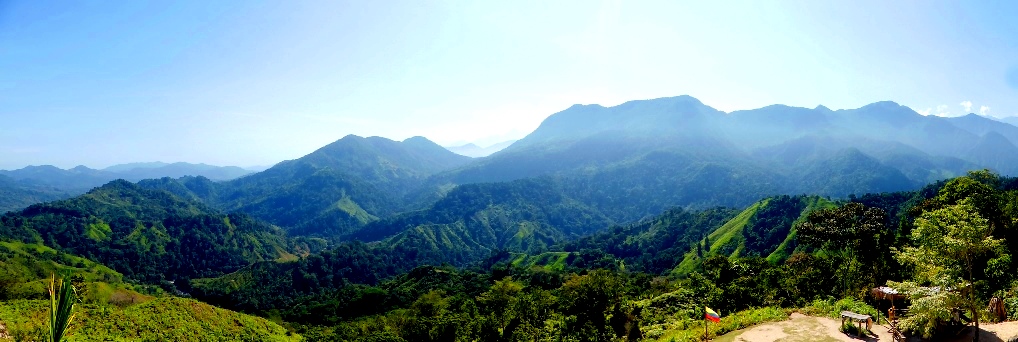
Perhaps as way of protecting their cultures from outsiders, the Wiwa guides are quite vague on many historic details of Teyuna itself, which was built around AD800 by the now-disappeared Tairona culture. On the four-day trek we have around 3 hours at the site, starting at 6am with wading across the Buritaca River then a slog up thousands of stone steps to the mountain spur. The site follows the spur up the mountain (more steps!) with a series of round or oval grassy terraces set in stone walls (a bit like a Dr Seuss-designed golf course) and a few features such as carved rocks.
According to Celso this was a town ‘built for and then gifted to the four tribes´ by the Tairona people who were like a race of demi-gods. Other sources suggest the Tairona split into four distinct tribes, the Kogi, Wiwa, Arhuaca and Kankuamo people. More likely that Teyuna was built by lost ancestors, the Tairona, then at a later date inhabited and used by one or more of the modern communities, dominated by Kogi and Wiwa who are present in the Buritaca Valley.
One puzzling aspect of the four tribes is that they share so many common cultural aspects but have quite distinct languages, as Celso demonstrated by greeting us in the four tongues. Today the Wiwa and Kankuamo are more assimilated with modern Colombia, and the Kankuamo have lost their native language except for songs. Wiwa still speak their language as a mother tongue, but live closer to campesino settlements. Kogi, which means jaguar, are seen as the most hard-core group preserving most of their traditions, having the least contact with the outside world, and tending to live in villages that are remoter and higher up the mountains.
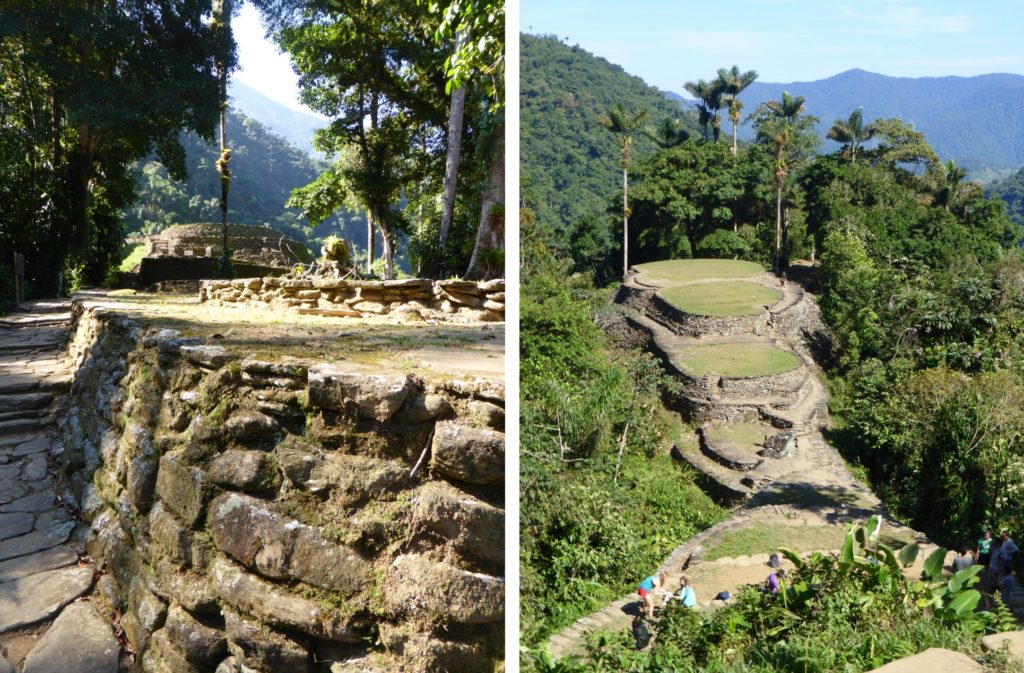
Mamo Number 5!
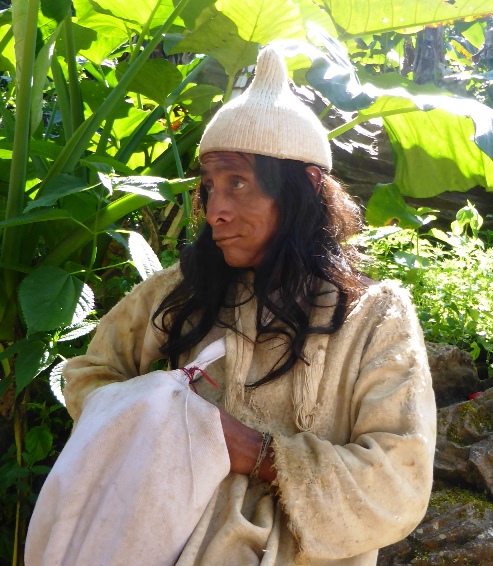
Close to the ruins is a traditional Kogi settlement with thatched huts with twin-peaked roofs, which represent the sierra snow-caps of Pico Bolivar and Pico Colon. There a Kogi mamo, eyes bloodshot from a life of serious coca chewing,hold court and sells trinkets to the tourists for a dollar a shot. Mamos are priests, healers and spiritual leaders who undergo strict training since boyhood to memorize the lore of the ancients and, you guessed it, chew a lot of coca leaves.
In fact for them sitting around chewing coca is a form of acquiring wisdom (I can remember a few old-timers with a similar philosophy sipping beer in my local pub). With this coca-acquired insight they regard themselves as the Big Brothers of the world and the rest of us as mere Little Brothers.
After paying for our dollar trinkets our tour group starts a quick-fire Q&A session with the mamo. The foreign backpackers are keen to know how he solves the community’s problems. The mamo seems a bit taken aback by the detailed interrogation.

‘How do you deal with the difficult problems?´ we ask.
‘I go into my hut and think for a day and then come out with the answer,´ mamo relays back to us (Manuel the guide is translating to Kogi).
´What if it is a really hard problem?´ the team persists.
´Well, I might check up with some other more senior mamos,’ he replies.
´Do you ever get a question you do not know the answer to?’
The mamo looks a bit hacked off now.
´No,´ he says ´ We have all the answers´.
´Do you have any questions for us?´ I ask him.
´No.´ He replies curtly, like what-on-earth-can-I-learn from-you-guys.
Our Mamo meeting is over and another tour group shuffles in for more coca wisdom and dollar-trinkets. We head back through the jungle down to the river enjoying the toucans and a quick green snake (we see three on the trek and a recently-killed venomous mapana).
Later I ask Celso and Manuel if they have any desire to see other parts of Colombia or even travel abroad. Manuel looks at me like I am a bit mad. ´No, why would we go elsewhere? Everything we want is here in the sierra’. They really do believe it is the centre of the universe.
Any why not? I have seen a lot of places but nothing quite combines in terms of nature, geography, climate and architecture to match the paradise that is Teyuna.
PRACTICAL STUFF
Where to start: the coastal city of Santa Marta is the gateway to the trip, and the tour companies are mostly based in and around the old city area.
Booking the trip: To get the best price, book your trip directly with the tour operators in Santa Marta, their contact details are here on the Wikitravel page. You can arrive and book on arrival in Santa Marta (there are tours leaving daily and usually space) or if you prefer to boom ahead you can email or phone the companies to make a reservation. In theory they ask for a 10% online payment to secure the place, which you can pay by credit card (follow the instruction on the tour company websites). If you prefer not to pay a deposit and have a bit of flexibility on your tour date it is probably fine just to rock up and pay the whole lot in Santa Marta.

Which tour? I recommend Wiwatours because of their Wiwa guides. The tour was also very well organised.
What to bring? Bring with you as little as possible. Food, water, hammocks (or in some camps, bunk beds), mosquito nets, and blankets are provided.The tour companies give a good kit lists on their websites, as does the Wiki Travel site , but also check the links to other blogs below for more detailed lists and explanation. Do make sure you have:
- a good head-torch (not all camps have light at night)
- small camera (in waterproof bag)
- jungle-formula (DEET) repellent. Re-apply it after swimming.
- a warm top and long trousers for at night (for chill air and keep off bugs)
- a sun hat (trek is mostly shaded but some sunny areas)
- good worn-in walking boots. I do not recommend light tennis shoes, as the trail is rocky and many people slip so there is a risk of a twisted ankle.
- swim gear for swim holes and lycra shorts/top for walking.
- spare shoes (sandals) for at night, socks, pants and T-shirt (quick-dry).
- cash to buy beers and fizzy drinks
- pack of cards
- small bottle of spirits to share (you can also buy in the camps, but expensive).
- waterproof poncho for wet season (can buy locally in Santa Marta)
- plastic bags to keep clothes dry
- small first aid kit with plasters (everyone gets blisters), tweezers (to safely remove ticks) pain-killers and stomach pain relief (ie Buscapan) in case of tummy upset (unlikely), anti-histamine pills (to reduce bites and help sleep at night) and/or anti-histamine cream, antiseptic cream (ie Germoline).
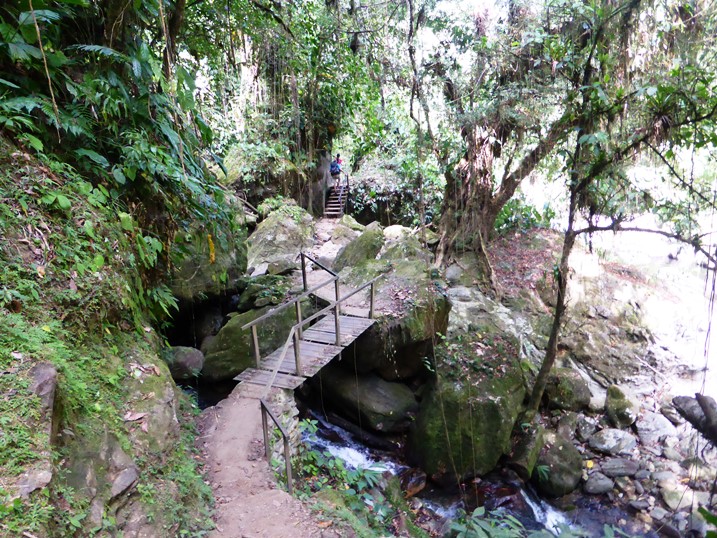
The walking bit. The trails is 47 kms return at a low altitude of 450 metre to 1200 metres (at the Lost City itself) and In the dry season most reasonably fit walkers will find the hiking easy with plenty of time to reach destinations and spare time to chill and swim in river. If like me you prefer to walk slowly but steadily with fewer stops, you will find the frequent stops frustrating. I asked the guides if I could set off early from camp and walk ahead (which was also a chance to see wildlife) which was fine, but be aware there are detours in the path and if in doubt wait of which way to go then stop and for the rest of the team. If you are unfit or have leg or knee problems you will find the long steep ascents and descents hard, but there are plenty of chances to rest and take a breath. As a last resort you can hire a mule for yourself or your pack, but it will cost more.
In the wet season the (August to November) the trail can be muddy, the rivers deep for crossing, and the trail much tougher. Take this into account when deciding if you want to do the 4, 5 or 6-day trek.
Life on the trail. The tour companies give a good itinerary, but generally you walk between camps where lunch or overnight stops are provided. The camps are large open tin-roofed buildings with a dirt floor and hammocks or bunk beds (early arrivals get the more comfortable bunks!). Cooking is ´campesino style´ over a wood fire and rice, beans, meat or chicken with some fruit (pineapple or watermelon) and a natural fruit drink. Water is treated with chlorine tablets, or you can buy bottled water, soft drinks or beer at the camp kiosks.
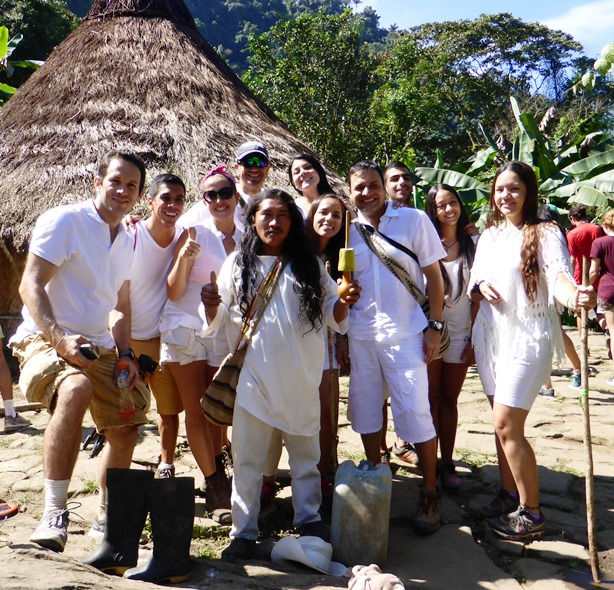
There is no internet or cellphone connection, so after dinner most people sit and sip beer and tell yarns or play cards. Breakfast is eggs, arepas and coffee or hot chocolate at 6am and you pack and hit the trail at around 6.30am to get the walking done before the midday heat. There is always the river nearby to swim or freshen up at lunchtime or before dinner. There are also showers and toilets in the camps, basic but clean and working fine.
The tour guides give basic information but do not always offer details. But if you take time to get to know them and ask questions you will find out a lot more.
Guides speak Spanish but usually there are bilingual people in the tour group happy to translate.
Look after your body by –
- Apply a lot of insect repellent and use long trousers at night to reduce sandfly bites (which are not dangerous unless they get infected). Keep your fingernails short and don’t scratch!
- Drink lots, keep hydrated and in the shade. You can buy Gatorade at most drink stops.
- Look after your feet, use sandals to wade rivers (avoid to go barefoot anywhere). Try to dry your feet and keep your walking boots dry, this will reduce blisters.
- If you go off the trail be careful of well-camouflaged snakes (mapana, very venomous), banana spiders (also poisonous) etc. These critters won´t kill you but will bring a painful end to your trek.
- If you get a stomach bug, tell your guides, they will find ways to make you more comfortable (coca and camomile tea) and can arrange a mule to carry you some way or your bags (at extra cost).
